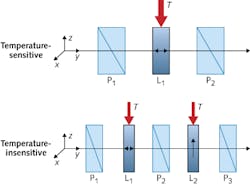Transmission spectrum of birefringent optical filter is temperature-insensitive
Birefringence-based optical filters have many uses, including dense wavelength-division multiplexing, astronomy, laser tuning, and others. One pre-existing type of birefringent filter contains two polarizing Glan prisms (P1 and P2) sandwiching a quartz waveplate (L1); in such a structure, a change in the temperature T of the device changes the center wavelength of the filter—an undesirable outcome. Researchers at Shanghai University of Engineering Science (Shanghai, China) have developed an alternative version of this device that is temperature-stable, and have analytically characterized it.
The new filter has three Glan prisms (P1, P2, and P3) and two quartz waveplates (L1 and L2). L1 (the rotation crystal) has its quartz optical axis perpendicular to its surfaces, while L2 (the birefringence crystal) has its quartz optical axis parallel to its surfaces. If the device is subjected to a temperature increase, the quartz-specific rotation in L1 will increase and the quartz birefringence in L2 will decrease. If plate thicknesses are chosen properly, the two effects will cancel each other and will lead to almost no change in output wavelength as a function of temperature. A numerical simulation over the 400–600 nm wavelength band for both types of devices bears this out; experimental results are forthcoming. Contact Fei Gao at [email protected].

John Wallace | Senior Technical Editor (1998-2022)
John Wallace was with Laser Focus World for nearly 25 years, retiring in late June 2022. He obtained a bachelor's degree in mechanical engineering and physics at Rutgers University and a master's in optical engineering at the University of Rochester. Before becoming an editor, John worked as an engineer at RCA, Exxon, Eastman Kodak, and GCA Corporation.
